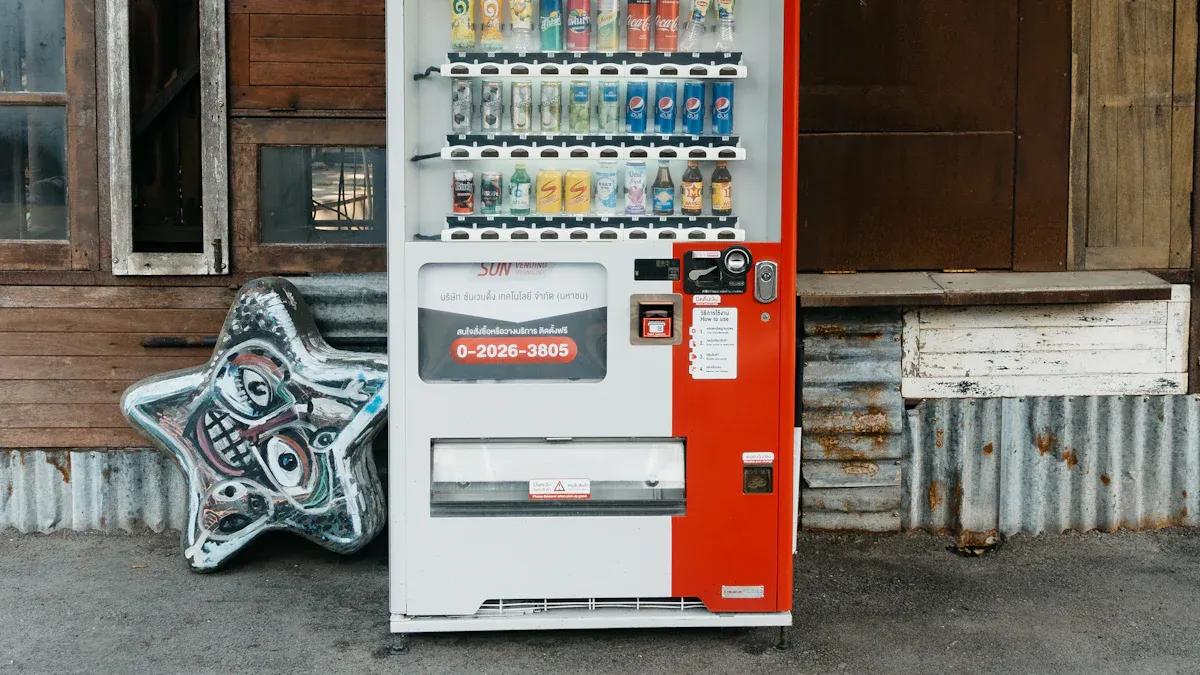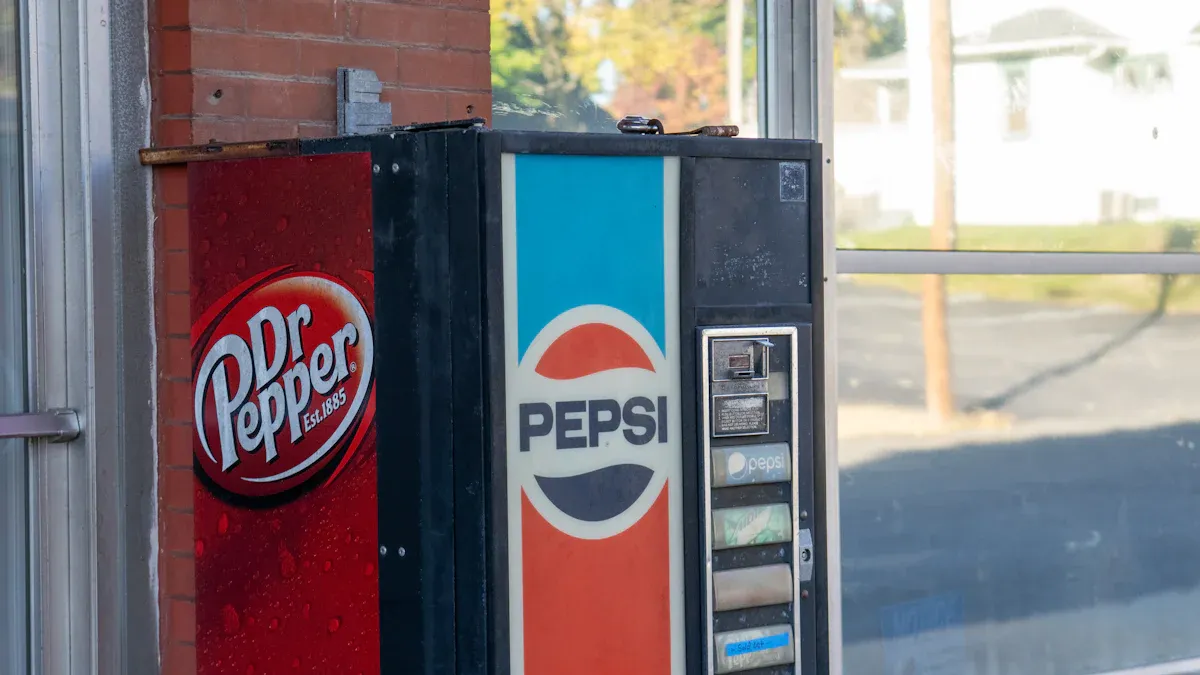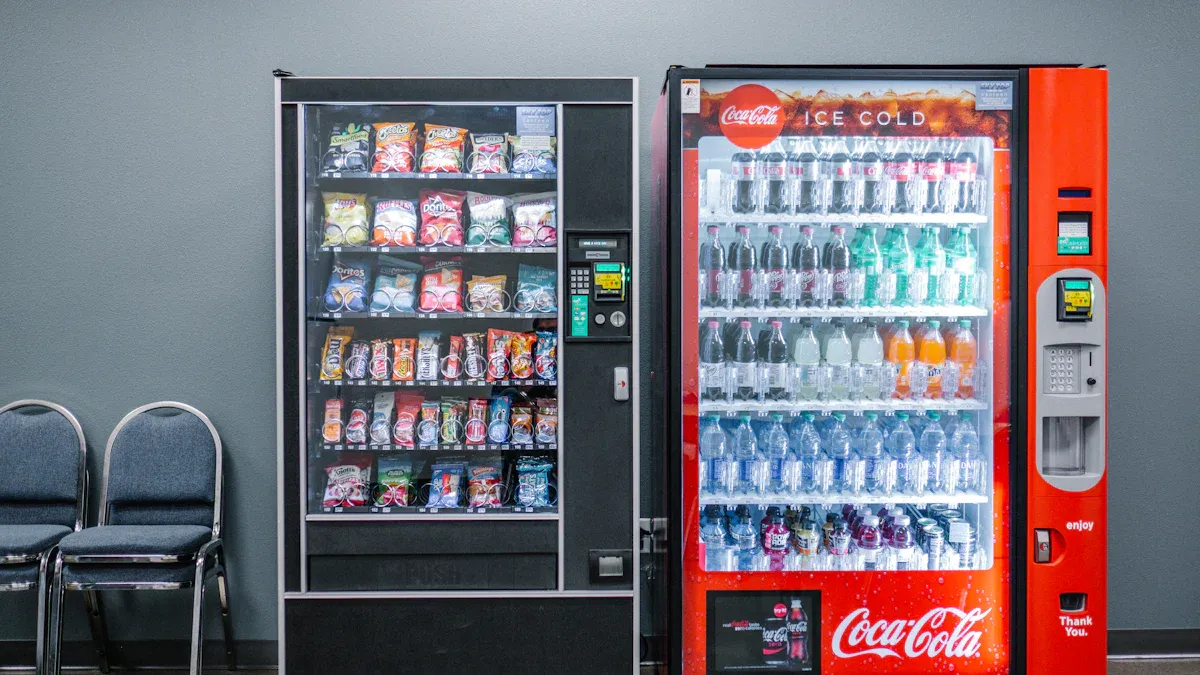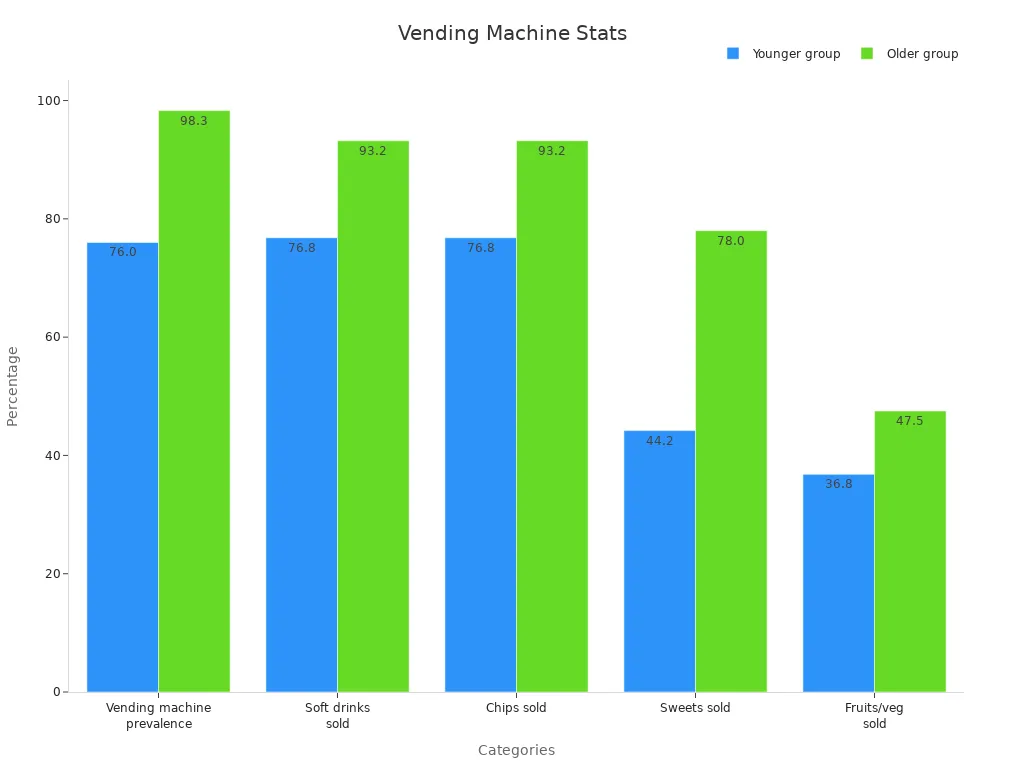The Nostalgic Evolution of 2000s Soda Vending Machines

The hum of a 2000s soda vending machine filled the hallway, followed by the satisfying clunk as a cold can dropped into the tray. For many, these machines brought instant convenience. Their bright colors, famous soda logos, and bold designs stood out in schools and offices. People connected with the Nostalgic Evolution of these machines. They offered more than a drink—they delivered a small moment of convenience, a taste of something familiar, and a glimpse of retro style mixed with new technology.
Key Takeaways
2000s soda vending machines combined bright designs and new technology to create a fun and easy way to get drinks.
Digital screens, touch buttons, and cashless payments made buying soda faster and more interactive.
These machines became part of daily life, shaping social moments in schools, malls, and offices.
Combo machines expanded choices by offering snacks and meals, making vending more convenient.
Collectors treasure these machines for their nostalgic value and unique style, keeping their history alive.
Nostalgic Evolution

2000s Soda Vending Machines
The nostalgic evolution of 2000s soda vending machines stands out in the history of vending machines. These machines did more than just serve a cold soda. They became icons in schools, malls, and offices. People remember the bright lights, the hum of the machine, and the thrill of watching a can drop into the tray. The machines brought together the best of old and new. They mixed the comfort of familiar brands with the excitement of new technology.
In the early 2000s, vending machines started to change fast. Operators began using internet-connected machines to track sales and fix problems from far away. Cashless payment systems replaced the need for coins and bills. This made buying a soda faster and easier for everyone. Micro markets also appeared, offering more choices and self-checkout options. Some machines even used computer vision to recognize what customers picked up, making the experience feel futuristic.
Many people felt a strong connection to these machines. They became part of daily routines and special moments. The nostalgic evolution of these machines shows how technology and emotion can work together.
Design Trends
Designs in the 2000s took inspiration from the Y2K era. Vending machines featured bold designs with bright, brand-specific colors like Coca-Cola red and Pepsi blue. The Coca-Cola logo update in 2003 added texture, bubbles, and multi-dimensional colors. These changes matched the maximalist style of the time. The machines used glossy finishes, neon lights, and rounded shapes. These features made them easy to spot and hard to forget.
Designs also became more compact. Machines fit into tight spaces in subway stations, schools, and offices. Digital displays and touch buttons replaced old mechanical parts. This made the machines more user-friendly and interactive. Energy-efficient cooling systems became common after the 2004 ENERGY STAR standards. These changes saved energy and helped the environment.
Key features of 2000s soda vending machines:
Bold designs with vibrant colors and famous logos
Digital screens and touch buttons for easy use
Compact shapes for urban spaces
Cashless payment options
The nostalgic evolution of these machines reflects a time when vending became more than just a way to get a drink. It became a part of culture, style, and daily life. The history of vending machines shows how each new design and feature brought people closer to their favorite soda. The emotional bond people formed with these machines still lasts today. The story of 2000s soda vending machines is a key chapter in the history of vending machines and the world of drink vending machines.
Technology Shifts

Digital Screens
In the 2000s, vending machines started to look different. Many machines replaced old plastic windows with bright digital screens. These screens showed colorful ads, product choices, and even fun animations. People could see what drinks were inside before making a choice. Digital screens made vending more exciting and helped brands stand out. They also let operators update prices or products without opening the machines. This new technology made vending machines smarter and more helpful for everyone.
Touch Features
Touch features changed the way people used vending machines. Instead of pushing hard buttons, users could tap on a screen to pick their drink. This made the process feel like an interactive experience. Kids and adults both enjoyed the smooth, modern feel. Touch screens also made it easier to add new products or show special deals. Vending became more than just buying a soda—it became a quick, fun moment in the day. Many people remember the first time they used a touch screen on a vending machine and felt like they were in the future.
Touch technology turned every soda run into an interactive experience, making vending machines feel fresh and modern.
Cashless Payments
Cashless payment systems became a big deal in the 2000s. People wanted faster, safer ways to buy drinks. Machines started to accept credit cards, contactless cards, and even mobile payments. This shift matched busy lifestyles and growing concerns about hygiene. NFC tap-to-pay technology made buying a drink quick and easy. Vending operators liked cashless payment systems because they were safer and less likely to break. Studies showed that most people wanted faster checkout options, and many would leave if lines were too long. Cashless vending helped keep up with these new demands and made vending machines a part of modern life.
Key benefits of cashless vending:
Faster transactions
Safer and cleaner
Less need for staff
More choices for customers
Vending machines in the 2000s became more than simple snack boxes. With digital screens, touch features, and cashless payment systems, vending turned into a smart, interactive part of daily life.
Convenience and Culture
Everyday Life
Vending machines became a true symbol of convenience in the 2000s. People could grab a cold soda or snack without waiting in line. These machines popped up everywhere—schools, malls, and offices. Students loved the quick access between classes. Workers enjoyed a fast break without leaving the building. Parents found them helpful during busy shopping trips.
A look at the numbers shows just how common vending machines were. In 2005-2006, 83% of public schools had vending machines. Younger grades saw 76% of schools with machines, while older grades reached 98.3%. Most machines sold soft drinks, chips, and sweets. Healthy options like fruits or vegetables appeared less often.
Statistic Description | Value / Finding |
|---|---|
Percentage of public schools with vending machines (2005-2006) | 83% |
Vending machine prevalence by grade group | Younger grades (6-8): 76.0% vs Older grades (9-10): 98.3% (significant difference, p < 0.001) |
Common items sold in vending machines | Soft drinks (76.8% younger, 93.2% older), Chips (76.8% younger, 93.2% older), Sweets (44.2% younger, 78.0% older) |
Less common healthy items | Fruits/vegetables (36.8% younger, 47.5% older) |
Effect on consumption by grade | Younger students consume more of items available in vending machines; no significant effect in older grades |
Vending machines made daily life easier and shaped how people snacked and drank during the day.
Social Spaces
Vending machines changed the way people interacted in public spaces. In schools, students gathered around machines during breaks. They shared stories, swapped snacks, and made new friends. Malls used vending machines to keep shoppers refreshed and happy. Offices placed machines in break rooms, turning them into social hubs.
A large study in Canada found that students in schools with soda vending machines drank more sugar-sweetened beverages. Schools with strong nutrition rules saw students drink less soda and have lower BMI. This shows how vending machines influenced not just habits, but also health and social life.

Among 646 students using school vending machines, 71% purchased sugar-sweetened beverages.
66% of students reported eating at fast-food restaurants.
Average sugar-sweetened beverage intake was 1.2 servings per day.
More vending purchases meant more sugary drinks.
Vending use had a strong link to daily drink choices.
Brand Icons
Vending machines in the 2000s became more than just tools for convenience. They turned into brand icons. The bright logos of soda companies stood out in every hallway and food court. People recognized these machines instantly. The machines became part of pop culture, showing up in movies, TV shows, and even music videos. Their cultural significance grew as they shaped trends and daily routines.
Vending machines in this era blended convenience, style, and social life. They left a mark on how people saw brands and enjoyed quick treats.
Beyond Soda
Combo Machines
Combo machines started to appear everywhere in the 2000s. These vending machines offered more than just soda. People could buy snacks, bottled drinks, frozen meals, or even ice cream from a single machine. This change made life easier for busy students and workers. They did not need to search for different machines to get what they wanted.
The market for combo vending machines keeps growing fast.
New technology like IoT, cloud computing, and RFID helps these machines track inventory and offer more choices.
Smart vending machines now serve many places, from hospitals to airports.
Companies invest in new designs and features to keep up with changing needs.
Combo machines show how vending machines adapt to what people want. They make it simple to grab a drink or snack on the go.
Collectibles
Many people now collect 2000s soda vending machines. These machines remind them of school days or fun times at the mall. Collectors look for machines with classic logos, bright colors, or special features. Some even restore old machines and display them at home.
Collecting these machines brings back memories and keeps a piece of history alive.
Collectors often share stories about their favorite finds. They enjoy the hunt for rare models and the challenge of fixing them up. These machines have become more than just tools—they are treasures from the past.
Modern Vending
Modern vending solutions have changed the way people buy drinks and snacks. Old machines used coins and had only a few choices. Today’s machines use touch screens, cashless payments, and even mobile wallets. Some machines track what sells best and show ads or special deals.
Modern vending solutions use smart technology to make shopping easy and fun. People can find fresh food, bottled drinks, and even healthy snacks. The future of vending machines looks bright, with more choices and better experiences for everyone.
Smart vending machines now lead the market, offering fast service and new ways to shop.
The legacy of 2000s soda vending machines lives on. These machines bridged the gap between old-school charm and new technology. People still remember the bright colors, cool features, and the thrill of grabbing a cold drink. Nostalgia sticks because these machines became part of daily life and special moments.
Do you have a favorite memory with a soda vending machine?
Share your stories or thoughts in the comments below!
What was your go-to drink?
Did you ever collect vending machine items?
How do you feel about today’s smart vending machines?
FAQ
What made 2000s soda vending machines so memorable?
Bright colors, bold logos, and new tech made these machines stand out. People loved the mix of old-school charm and modern features. Many remember the thrill of grabbing a cold drink during a busy day.
Can people still find 2000s soda vending machines today?
Yes! Some schools, offices, and collectors still have them. Many fans buy and restore these machines for home use. Online marketplaces often list classic models for sale.
Why do collectors love 2000s soda vending machines?
Collectors enjoy the nostalgia and unique designs. They look for rare logos, special features, or limited editions. Restoring a machine can feel like bringing a piece of history back to life.
How did technology change vending machines in the 2000s?
Machines switched from coins to cashless payments. Digital screens and touch features made buying drinks easier. Operators could track sales and fix problems faster with smart tech.
Did soda vending machines affect pop culture?
Absolutely! These machines showed up in movies, TV shows, and music videos. They became symbols of convenience and fun. Many people still remember their favorite soda runs with friends.
See Also
Mountain Dew Vending Machines Through Time: Classic To Cutting-Edge
How Vending Machines Transformed From Snacks To Smart Devices
Antique Vending Machines History: Holy Water To Coca-Cola Era
MP3 Vending Machines Development: From Past To Present Innovations
Edible Vending Machines Changing The Way Snacks Are Accessed
